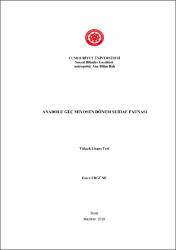| dc.contributor.advisor | Kırmızıoğlu, Pınar Gözlük | |
| dc.contributor.author | Ergüne, Emre | |
| dc.date.accessioned | 2022-04-28T08:55:33Z | |
| dc.date.available | 2022-04-28T08:55:33Z | |
| dc.date.issued | 2018 | tr |
| dc.date.submitted | 2018-06-06 | |
| dc.identifier.other | XI, 79 sayfa | |
| dc.identifier.uri | https://hdl.handle.net/20.500.12418/12504 | |
| dc.description.abstract | Anadolu’da Geç Miyosen Suidae fosil lokalitelerinin analizi, değerlendiril mesi ve karşılaştırılması bu tez kapsamında ele alınmıştır. Buluntu yerlerine ayrıntılı olarak değinilmiş, yapılan stratigrafik, paleontolojik, paleoekolojik ve jeolojik çalış malar incelenmiştir. Anadolu’da yürütülen Miyosen dönem paleontoloji çalışmaları, kazı ve yüzey araştırmaları, bu konularda yayınlanmış bilimsel literatürden elde edi len veriler sonucunda, toplam 31 Geç Miyosen lokalitesinden 6 genus saptanmıştır. Fosiller geniş yayılım alanı gösterdiğinden, araştırmalar 4 coğrafik bölgede derlen miştir. Bunlar; İç Anadolu Bölgesi, Ege Bölgesi, Marmara Bölgesi ve Akdeniz Böl gesi’dir. Lokalitelerin çoğunda türü belirlenememiş fosil örneklerde kaydedilmiştir. Suid türleri yoğun olarak İç Anadolu Bölgesi, Ege Bölgesi ve Akdeniz Bölge si’ndedir. Bu bilgiler çerçevesinde, Geç Miyosen dönemde Anadolu’da açık alanların ve düzlüklerin yoğun bulunması nedeniyle, Suidae alt ailesi için elverişli yaşam alan-larının varlığından söz edilmektedir. Hippopotamodon – Microstonyx genuslarının varlığı Geç Miyosen dönemle özdeşleşmekte ve bize jeolojik açıdan bölge yaş aralı ğını vermektedir. Yapılan çalışmalar, Anadolu’da Suidlerin geniş bir yayılım alnına sahip olduğunu göstermiştir. Ancak az sayıda türle temsil edilmektedir. Suidler Geç Miyosenle başlayan kurak ve açık alanlara uyum sağlayarak hayatta kalmayı başardı-lar. Anadolu’daki taksonları oldukça karmaşıktır. | tr |
| dc.description.abstract | This study composes a compherensive analysis of Suidae bearing fossil loca lities from the Late Miocene in Anatolia. Previous and ongoing Miocene paleontolo gical studies, surveys, and excavations are investigated in terms of geologic, paleon-tologic, stratigraphic, and paleoecologic perspectives. The study area is divided into four geographic regions due to the wide range of fossil sites including Central Anato lian Region, Aegean Region, Marmara Region, and Mediterranean Region. Accor ding to this, six different genera are recorded out of 31 Anatolian Late Miocene sites. Additionally, taxonomically pending specimens are also recorded from most of these sites. Central Anatolian, Aegean, and Mediterranean sites contain a high number of suid species. It has been suggested that vast regions of Anatolia were covered by savanna type ecosystems during the late Miocene which provided favorable habitats for members of Suidae. The most common genera of the Late Miocene are Hippopo tamodon and Microstonyx, and their suggests an approximate biochronologic age for the late Miocene. All in all, this study confirms that members of Suidae are spatially distributed across a vast region in Anatolia. They survived during increasingly open habitats and seasonality by the late Miocene, however they represent low species diversity. Their intrageneric taxonomical definitiaion is higly complicated. | tr |
| dc.language.iso | tur | tr |
| dc.publisher | Sivas Cumhuriyet Üniversitesi - Sosyal Bilimler Enstitüsü | tr |
| dc.rights | info:eu-repo/semantics/openAccess | tr |
| dc.subject | Suidae | tr |
| dc.subject | Geç Miyosen | tr |
| dc.subject | Paleontoloji | tr |
| dc.subject | Paleobiyocoğrafya | tr |
| dc.title | Anadolu Geç Miyosen Dönem Suidae Faunası | tr |
| dc.type | masterThesis | tr |
| dc.contributor.department | Sosyal Bilimler Enstitüsü | tr |
| dc.relation.publicationcategory | Tez | tr |















